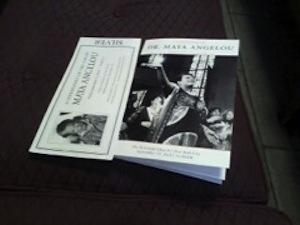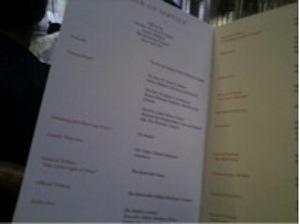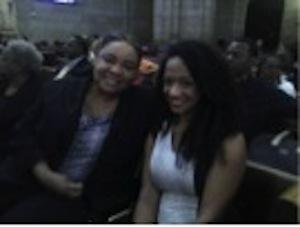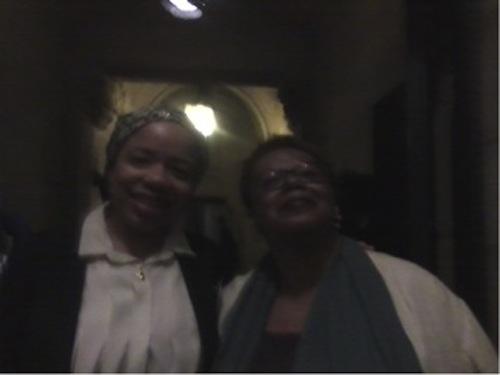Hanging with the Big Girls in My Traveling Shoes
Last year when I was invited to receive an award from the Black Students Association at Rhodes College as part of my 40th College Reunion, I was freaked out. I had a few weeks earlier been to Arkansas to bury my mother and what little money I had was gone. But to be honored as a Distinguished Alumni for a group I helped to organize decades before was an important opportunity I could not say no to. A very good friend, a wonderful novelist and elder heard about my honor and knew my predicament. She took me to a shoe store on Broadway and let me choose a pair of beautiful, well made dress shoes. I would not look like a poor poet at such a gathering. They are in a way my “traveling shoes,” the ones for readings and special events: memorials, weddings, high teas. They are the shoes I wore to A Celebration of Dr. Maya Angelou at Riverside Church on September 12.

I think Maya would appreciate my telling some of the tales out of school—my financial difficulties; my friends generosity; the fact that I helped start an organization at a college I graduated from 40 years ago that is still in business; that I buried my mother. She seems to have had all of those things: poverty, friends’ generosity; mother loss; starting up many organizations that have morphed into major national and or international institutions. My small story is an echo of her larger one, but then like many of the women she hung with in the 1960s and 1970s, Maya Angelou truly was larger than life.
In this Year of James Baldwin, I was a panelist on Baldwin’s legacy at Columbia University. Another panel of that day included Rashidah Ismaili, Pamela Sneed and Mendi Obadike discussing the artists’ struggle for integrity in light of Baldwin’s essay. That was all well and good and then Rashidah talked about Baldwin in community, which is how he was treated when he returned to New York from Paris. She said she went to a party organized by “the big girls” in Paule Marshall’s then upper west side apartment. Maya cooked, Rosa Guy sang, there was much drinking and dancing and gossiping. Baldwin was welcomed back to his hometown in style. Big girls. Just think of them: Louise Meriweather is like 6 feet tall; Maya was over 6 feet; Rosa Guy was no shrinking violet and while Paule Marshall is shorter in stature, no one can claim her as a little woman. EVER. Baldwin must have been in 7th heaven with all those big girls singing him back home.
When Toni Morrison spoke slowly, yet firmly at the Celebration about “the intimate moments” of their friendship—I can see her and Angelou clasping each other’s hands and saying we got to hold each other up until one of us can no longer do that. It was also hard to see Toni in a wheel chair—just reminds me of her coming to parties on the upper west side or at CCLM –big hair, big laugh, and big handbag in a rush.

In the 1970s, while Angelou and Marshall and Guy and Meriweather were starting to really make their considerable marks, new “big girls” showed up. It is coming up on the 40th anniversary of the premier of For Colored Girls and despite that god awful film by Tyler Perry, the choreopoem still resonates. I was at the opening night of the premier at the Public Theater. I know you may not believe it, but the stage lifted up from the power and excitement of the work. Cultural feminism was everywhere: the theater, in magazines; on film; in dance and performance; conceptual art—Laurie Anderson was in the same Barnard class as Ntozake Shange and Thulani Davis, give or take a year. I am still amazed to have been there, seen that, been part of the mix. Shange, Davis and Jessica Hagedorn came East from the Bay Area to downtown New York with a great deal of energy, ideas, beauty. They were part of a feminine and feminist energy that was not White. They had wilder hair, and wore bangles, flowy dresse with ballet shoes, African prints and scarves and dug jazz and jazz men. They performed their poetry–Thulani was/is a particularly strong performer with musicians and her sets with Cecil Taylor reverberate. Hagedorn brought an elegant toughness, that Pinoy flavor to the mix. Whenever she walked about, brothers would literally swoon—I know this, I saw them swoon. We were all so very young, so very pretty, so very intense. We wore out many traveling shoes.
These amazing Black women’s voices seemed to rule New York City in 1970s. Maya Angelou’s voice; Jayne Cortez’s voice; Paule Marshall, Audre Lorde, June Jordan voices, voices—fierce, funny—anyone who heard June laugh knew a good time was being had. We were privy to those voices. We learned to navigate the very bitter waters that surround this city, this nation. We learned to keep making work no matter what.
When I think of that feminine energy unleashed upon the world—all of us young women wearing bright colors; demanding to be seen/heard/understood and making things different, better, I can’t help but smile. Making rent, making dinner, making love, making poems, making a world safer for women and men for boys and girls, I look around at the coarse angry world we live in and want to scream—those who do not listen to women are doomed to make a world ugly and unsafe for anyone—see Syria, Iraq, northern Nigeria or the US/Mexico border where hundreds of women have been raped, murdered and just left on the road.
Violence is used across this nation and around the world to control women—to keep that feminine energy repressed and servile. The 1970s may have been the only decade where the voices, once heard, could not be easily re-framed, pushed aside or unheard. And while there are plenty of wonderfully noisy feminists and feminine voices now, Amy King, Metta Sama, Kimiko Hahn, Julie Patton, Lydia Cortes, Rachel Levitsky, Rachel Eliza Griffiths, Anne Waldman to name but a few—we rarely get to possess public space in that way. To have seen the actresses in For Colored Girls walk out onto Lafayette and almost stop traffic is to know that women can possess public space in a powerful way. To have seen Patti Smith literally silence the drunken bunch at CBGBs when she wanted to, well.

At the Celebration, Hilary Clinton noted that Maya urged us to be kinder, braver. I think right now she would urge us to struggle for justice—to not let up. Angelou’s life is about allowing a voice to not only open up, but to sing LOUD AND CLEAR. When I read I Know Why the Caged Bird Sings, I understood all too well the kind of town she lived in. I grew up in a small town in Arkansas. But in many ways, hers was even more oppressive and that is saying something. Arkansas has never been a kind place for Black people, which is why Blacks in/from Arkansas are brave. We have to be. Much about the state is closed off, because as I once said to a gentlemen at a dinner at Williams College when I was running The New Works program of the Massachusetts Council on the Arts, who asked what Arkansas was like. Well, said I, Arkansas is like Switzerland. It is landlocked and surrounded by bigger and sometimes hostile states. So Arkansans are very polite. We are much closed. People travel across the state, but rarely stop and stay, except for a few days here and there. This can mean that communities are close-knit and watchful or corrupt and repressive and depending on race and status, you could be involved in both kinds of communities. Maybe that is why poets from Arkansas are an odd bunch: Henry Dumas, brilliant beyond words, killed by a transit cop; Frank Stanford, quirky and self-destructive; C. D. Wright is learned and philanthropic; Barbara Barg, who rocked and rolled the East Village but somehow kept that slight drawly twang; and I think of myself as part of this odd bunch-making poems that clearly express my experience as a New Yorker, but that Delta girl in me is always looking at the big sky trying to fathom what/where/how I will be. Living or dead, we and other Arkansans often travel far and wide to get where the language takes us.
Angelou’s son Guy Johnson, also in a wheel chair—he has had many operations—told many a rambling story about growing up with a very eccentric mother. He seemed both grateful and sort of annoyed, which made his comments that more endearing. The story I liked the best was that when they lived in Ghana, Malcolm X came for a visit. And what did his mother do, well she fried him some chicken. I have this image of Ms. Angelou, buying the chicken, probably plucking it; finding the oil-Crisco in Ghana and taking the time to season that chicken just right. Like the welcome for Baldwin, she made Malcolm X feel at home in Mother Africa. For Maya Angelou, her travels are now in the cosmos. I bet she is laughing and making fried chicken for Malcolm X (again).

Arkansas born and raised, and a resident of New York City for more than four decades, Patricia Spears Jones is a poet, educator, cultural activist, and anthologist. She is the author of The Beloved Community (Copper Canyon Press, 2023), A Lucent Fire: New & Selected Poems (2015), Painkiller (2010), Femme du Monde (2006), and The Weather...
